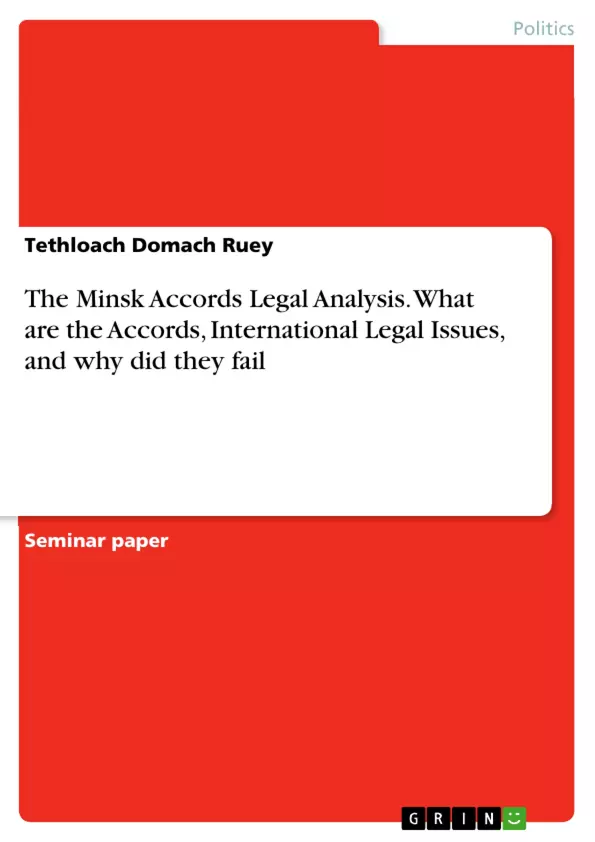The Minsk Accords addressed the conflict between Ukraine and the pro-Russian provinces of Donetsk and Luhansk. The object of the Accords was to cease hostilities in Eastern Ukraine, return the control of the provinces to Ukraine, and address the demands of Donetsk and Luhansk provinces. However, the deals collapsed due to their non-binding nature and the lack of compliance from the parties to the agreement. This paper examines the legal status of the Accords, their provisions, and the factors leading to their collapse.
Inhaltsverzeichnis (Table of Contents)
- Introduction
- 1. Background
- 2. The Accords
- a. The Minsk Protocol (Minsk I)
- b. Memorandum of 19 September 2014
Zielsetzung und Themenschwerpunkte (Objectives and Key Themes)
This paper analyzes the Minsk Accords, their international legal implications, and the reasons for their failure. It examines the Accords' legal standing, provisions, and the factors contributing to their collapse. The analysis focuses on whether the Accords possess international legal status and whether they adhered to principles outlined in the Vienna Convention on the Law of Treaties (1969) and the UN Charter.
- Legal status of the Minsk Accords
- Provisions and stipulations within the Minsk Accords
- Factors leading to the collapse of the Minsk Accords
- Compliance with international law (Vienna Convention and UN Charter)
- Role of Russia and other involved parties
Zusammenfassung der Kapitel (Chapter Summaries)
Introduction: This introductory chapter sets the stage for the analysis of the Minsk Accords, outlining the paper's objectives and providing a brief overview of its structure. It establishes the central argument that the Accords are legally non-binding due to their lack of international legal status, positing them as political arrangements favoring the Russian Federation. The chapter previews the subsequent chapters, each dedicated to exploring the historical context, the agreements' content, their signatories, their legal status, and a concluding summary.
1. Background: This chapter provides crucial historical context by detailing the political and social climate preceding the Minsk Accords. It focuses on the role of the Donbas region, its relationship with Ukraine and Russia, particularly highlighting former President Yanukovych’s influence and the annexation of Crimea. The chapter also mentions the cultural rights of ethnic minorities, the renunciation of the EU association agreement, and the resulting protests, all contributing factors to the escalating conflict. The emergence of Donbas separatists, supported by Russia, leading to the eventual signing of the Minsk Agreements, is also described, setting the stage for a deeper understanding of the accords' genesis.
2. The Accords: This chapter delves into the specifics of the Minsk Accords, examining both Minsk I (the Minsk Protocol) and the subsequent Memorandum of September 19, 2014. It details the key provisions of each agreement, such as ceasefire agreements, the withdrawal of heavy weaponry, and decentralization measures. The chapter highlights the conflicting aims and the rapid breakdown of the agreements, foreshadowing the later discussion of the agreements' legal standing and the reasons for their failure. The inclusion of both agreements emphasizes their interconnectedness and the attempts to salvage the initial accord.
Schlüsselwörter (Keywords)
Minsk Accords, international law, binding and registerable instruments, non-binding instruments, Ukraine, Russia, Donbas, conflict, ceasefire, international relations, Vienna Convention on the Law of Treaties, United Nations Charter.
Häufig gestellte Fragen (Frequently asked questions)
Was ist der Inhalt des vorliegenden Dokuments?
Das Dokument ist eine Sprachvorschau, die den Titel, das Inhaltsverzeichnis, die Ziele, die Themenschwerpunkte, Kapitelzusammenfassungen und Schlüsselwörter einer Analyse der Minsker Abkommen enthält.
Was sind die Hauptziele und Themenschwerpunkte der Analyse der Minsker Abkommen?
Die Analyse zielt darauf ab, die Minsker Abkommen, ihre internationalen rechtlichen Auswirkungen und die Gründe für ihr Scheitern zu untersuchen. Sie befasst sich mit dem rechtlichen Status der Abkommen, ihren Bestimmungen und den Faktoren, die zu ihrem Zusammenbruch beigetragen haben. Ein Schwerpunkt liegt auf der Frage, ob die Abkommen völkerrechtlichen Status besitzen und ob sie die Grundsätze des Wiener Übereinkommens über das Recht der Verträge (1969) und der UN-Charta einhalten.
Welche Kapitelzusammenfassungen sind enthalten?
Die Zusammenfassungen umfassen:
- Einleitung: Die Einleitung umreißt die Ziele der Analyse der Minsker Abkommen und bietet einen kurzen Überblick über die Struktur des Papiers. Sie stellt die zentrale These auf, dass die Abkommen aufgrund ihres fehlenden völkerrechtlichen Status rechtlich unverbindlich sind.
- 1. Hintergrund: Dieses Kapitel liefert den historischen Kontext, indem es das politische und soziale Klima vor den Minsker Abkommen beschreibt, insbesondere die Rolle des Donbas, seine Beziehung zur Ukraine und Russland, sowie die Annexion der Krim.
- 2. Die Abkommen: Dieses Kapitel befasst sich mit den Einzelheiten der Minsker Abkommen, sowohl Minsk I (das Minsker Protokoll) als auch dem nachfolgenden Memorandum vom 19. September 2014. Es beschreibt die wichtigsten Bestimmungen und das Scheitern der Abkommen.
Welche Schlüsselwörter werden im Zusammenhang mit der Analyse der Minsker Abkommen genannt?
Zu den Schlüsselwörtern gehören: Minsker Abkommen, Völkerrecht, bindende und eintragungsfähige Instrumente, unverbindliche Instrumente, Ukraine, Russland, Donbas, Konflikt, Waffenstillstand, internationale Beziehungen, Wiener Übereinkommen über das Recht der Verträge, Charta der Vereinten Nationen.
Was sind die spezifischen Vereinbarungen, die unter dem Begriff "Die Abkommen" fallen?
Unter "Die Abkommen" werden das Minsker Protokoll (Minsk I) und das Memorandum vom 19. September 2014 zusammengefasst.
Was sind die im Inhaltsverzeichnis aufgeführten Themen?
Das Inhaltsverzeichnis umfasst eine Einführung, einen Hintergrundabschnitt und einen Abschnitt über die Abkommen selbst, der Unterpunkte zum Minsker Protokoll (Minsk I) und zum Memorandum vom 19. September 2014 enthält.
- Citation du texte
- Dr Tethloach Domach Ruey (Auteur), 2024, The Minsk Accords Legal Analysis. What are the Accords, International Legal Issues, and why did they fail, Munich, GRIN Verlag, https://www.grin.com/document/1549234



